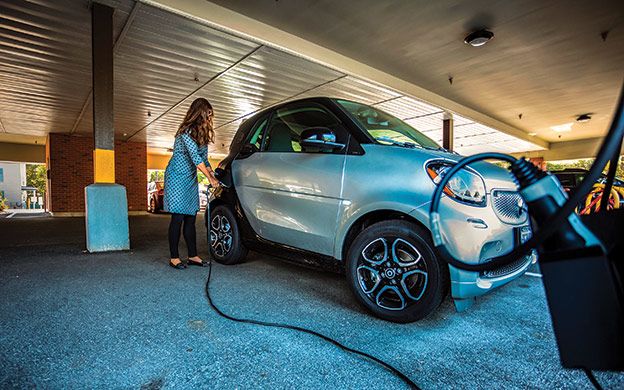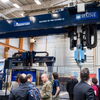
Green commute: Sustainable transportation options are trending
 Photo / Tim Greenway
Jennifer Brennan, the energy projects manager at Greater Portland Council of Governments, charges her Mercedes-Benz Smart Fortwo at the Level 2 charging station at the office in Portland.
Photo / Tim Greenway
Jennifer Brennan, the energy projects manager at Greater Portland Council of Governments, charges her Mercedes-Benz Smart Fortwo at the Level 2 charging station at the office in Portland.
Rick Harbison is one of a number of employees at the Greater Portland Council of Governments who commute in a “green” way.
For Harbison, that means biking 2.5 miles each way between home and work. In the winter, he dresses in a warm jacket and mittens, a hat under his helmet and sometimes a scarf over his face.
“It probably takes the same amount of time for me to bike as it does to drive,” he says. “It's a refreshing part of your day. Every day is a little bit of an adventure. Some days are pleasant and easy. Other days, in the winter, going around Back Cove you're like an Arctic explorer. But I've got mostly a desk job, so it adds variety to the day.”
Reflecting a national trend

Green commuting, also called “smart travel” and “smart commute,” is a nationwide trend that includes biking, walking, car-pooling, van-pooling, and public transit. For many Mainers, green commuting might not be a top-of-mind issue unless gas hits $4 per gallon and they start thinking about car-pools or public transportation. But green commuters cite parking congestion, convenience, and environmental and health benefits as top reasons to trade single-occupancy vehicles for other modes of transportation.
In Maine, green commuting has been getting a boost from Go Maine. A collaboration since the early 2000s between the Maine Department of Transportation and the Maine Turnpike Authority, Go Maine has primarily worked to encourage car-pooling and van-pooling, with 5,907 members in it database. The organization encourages other forms of green commuting, too, and held a promotion in October through its Way 2 Go Maine, a business-to-business commuter challenge. The challenge encourages employees to get their “greener commute on” by finding a carpool partner or commuting by bike or bus, then recording trips on Go Maine's leaderboard for the prospect of winning prizes for the most “greener” trips traveled.
Harbison, reached midway through the challenge, says Greater Portland Council of Governments was not only participating, its two dozen employees were so enthusiastic that they were shooting selfie videos of themselves commuting another way.
For some in his office, says Harbison, green commuting was nothing new. Many employees already car pool, walk or bike to work or take the public bus. One takes a ferry from her island home, then drives her electric car from the parking garage to work, where GPCOG installed an electric charging station, as it's been doing throughout the region. The farthest green commutes are probably from South Portland.
“I'm guessing it takes them 30 to 40 minutes,” Harbison says. “They go over the bridge and through the East End. It's a nice bike ride: A lot of it is off-road.”
Although GPCOG employees hadn't previously been using Go Maine's carpooling or ridesharing options, the challenge has inspired “a bunch” of new people to sign up, says Harbison. That includes one employee from Raymond, who has been experimenting with driving his car to a park-and-ride in Falmouth, then biking approximately 10 miles to work.
GPCOG encourages green commuting in other ways, too. It has bike racks for 10 to 15 bikes, a shower for biking commuters to freshen up, and an office bike for car commuters to use during the workday. Plus, the organization's location at Baxter Boulevard makes it easy to bike to external meetings.
“I enjoy it because it's a fun way to get to work,” says Harbison. “It feels like you're doing right by the environment. I like the way I feel when I get to work, having a little bit of exercise and not being beholden to the car all the time.”
Health, environmental benefits
Green commuters in Maine and elsewhere cite health and environmental benefits, but also fewer car-related headaches and expense.
At Google's Mountain View, Calif., headquarters, biodiesel-powered vans transport 4,500 employees, taking an estimated 3,000 cars off the road and reduced carbon emissions by 16,000 tons annually, Forbes reported in 2013. At that time, Google also had 240 EV chargers in its parking lots to support the corporate EV fleet.
At Dartmouth College, a green commute webpage makes it easy to find alternatives to single-occupancy cars. Initiatives include a car-sharing web tool for matching riders and drivers, free showers for bike, walk or run commuters, reduced-rate parking for car-pooling faculty and staff, free parking for three-person carpools, van-pooling provided by the college, a bike-share program, and an app that allows bus riders to track real-time bus locations.
In Maine, Go Maine is a primary driver for green commutes. The program:
- Provides ride matching
- Assists employers and employees with commuter options
- Works with planning agencies, businesses, advocacy groups and other partners to reduce the number of single-occupancy vehicles
- Develops commuter programs throughout the state.
Coordinator Rebecca Grover explains that car-poolers establish a Go Maine account to enter their information online and find matches. They can record their trips, making them eligible for rewards, like gift cards and discounts, based on the number of green trips they make. Go Maine also offers an emergency ride home benefit: For example, if a commuter who rode in someone else's car must leave work early due to an emergency, they can get a free car rental or taxi back home.
Although Go Maine is statewide, employers that use it most tend to be in densely populated areas like Portland and Augusta, says Grover. Outreach is typically done through radio ads and the occasional print ad, highway signage, and direct communication with employers, particularly those with transportation issues. Grover cites parking congestion in downtown Portland as just one scenario where Go Maine is useful.
“If everyone comes in a single-occupancy vehicle, and each one needs a parking space, that becomes an issue,” she says.
Another example of Go Maine's work was starting a van pool to help “new Mainers” who live in Lewiston get to jobs in Portland.
Shared parking spots
Grover says Portland-based MEMIC, which provides workers' comp insurance, has jumped onboard with the program.
“They've had to park all over creation to find spaces for their employees,” she says.
Brad Brunelle, MEMIC's purchasing manager and Grover's contact for coordinating the program, says parking in Portland is a challenge due to low supply and increasing demand. The topic has been on the table for a couple of years. While many employees live in Portland, there are clusters from places like Freeport, Biddeford, Saco or further away.
“We've talked about what we could do to help with car-pooling or to incentivize public transportation,” Brunelle says. The company signed onto Go Maine's challenge to launch its incentives. Now MEMIC is buying bus passes for employees who give up parking spaces; or MEMIC will pay for the space for those who car-pool and therefore share a space.
“A lot of people are interested,” Brunelle says. “It's just a matter of hesitation about giving up that parking space. It takes commitment to car-pool five days a week. The biggest challenge is we're asking them to share a parking spot. Someone might say, 'I can do it three days a week, but I'm having trouble the other two days.'” Addressing those concerns, MEMIC also offers to pay once a month for parking if a car-pooler needs to drive individually. “It gives them peace of mind knowing they have some support for days they can't car-pool,” he says.
The Jackson Laboratory in Bar Harbor as one of the biggest employers Go Maine works with. There, it's not about parking, but distance.
“The employees have awesome jobs, but the lab is hard to get to,” she says.
David Landry, the lab's manager of facility administrative services, says 125 to 135 employees ride the region's commuter bus system from as far as Bangor and other towns an hour or more away. That's partly because Bar Harbor has become too expensive for employees to live.
“The vast majority of folks now, as opposed to 20 to 30 years ago, live off-island,” he says.
So the lab since 2006 has subsidized the bus system. A certain number of seats are allocated to lab employees, who pay a subscriber or day fee.
“It's been great for employee recruitment,” Landry says. “Our employees can save a lot of money on mileage and gas.”A 100-mile round-trip from Hampden saves an estimated $4,000 per year: “It doesn't take long to add up,” he adds.
Surrounded by Acadia National Park, the lab thinks of itself as a steward of the environment.
“We'll do anything we can to help reduce CO2,” Landry says. “The more people we have commuting by bus or car-pooling makes a huge difference.”










Comments